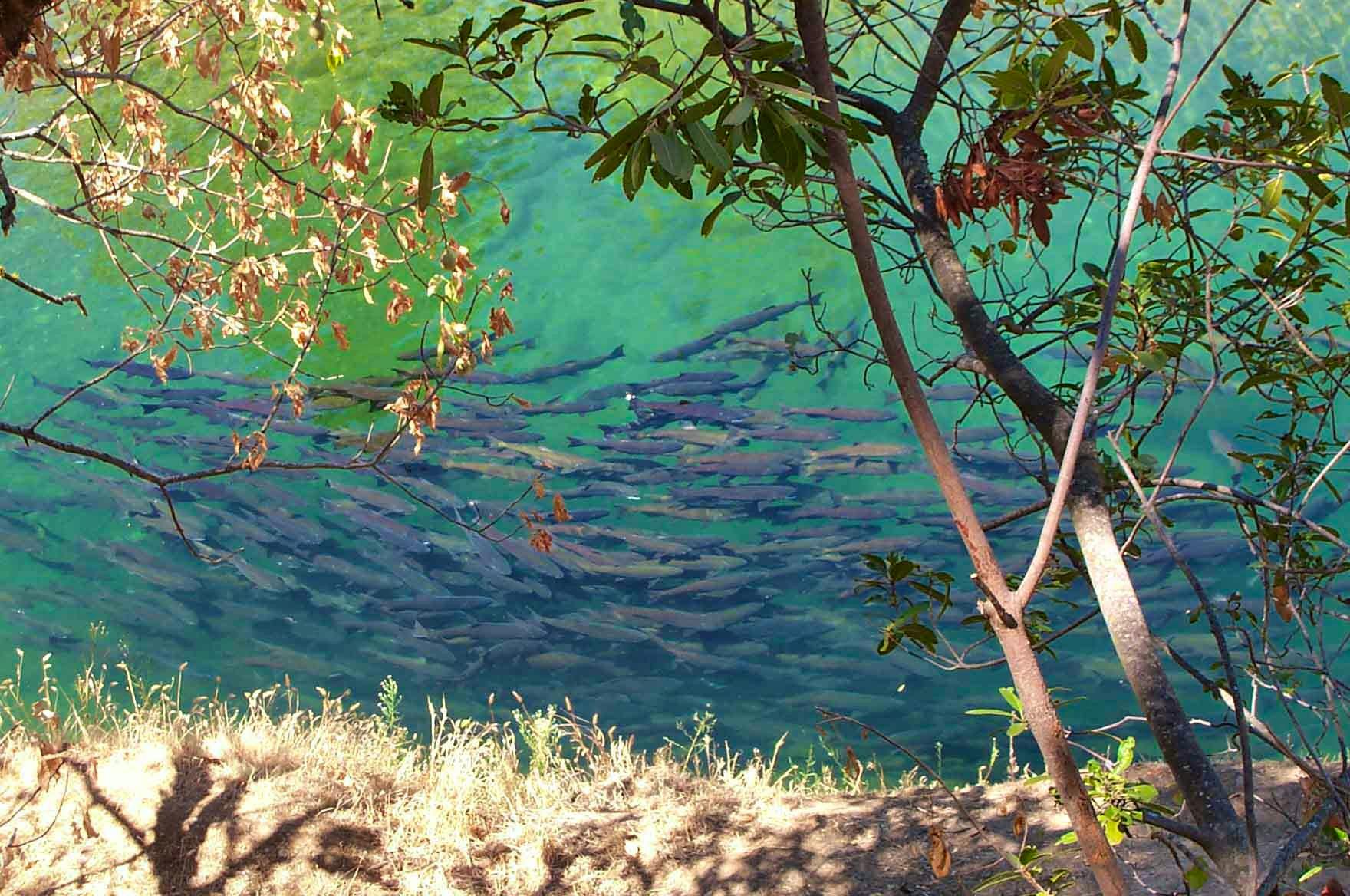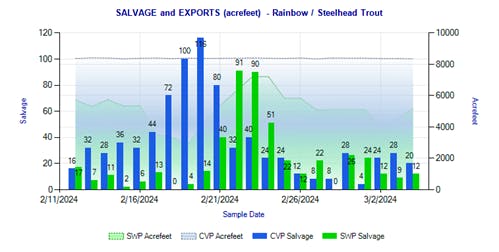Tweet“Between inadequate protections and the impacts of climate change, mass takes will become more common. As dozens more steelhead are killed today, it is a persistent reminder of the dire need for updated project operations that comply with the Endangered Species Act and protect the Bay-Delta Estuary.”
On March 6, a coalition of environmental and fishing groups reiterated their request that a federal court modify federal agencies’ proposed interim plan for operating the federal Central Valley Project (CVP), in coordination with the State Water Project (SWP), to protect fish species listed under the Endangered Species Act (ESA) and California Endangered Species Act (CESA). That coalition includes the Pacific Coast Federation of Fishermen’s Associations, the Golden State Salmon Association, The Bay Institute, Defenders of Wildlife, and Natural Resources Defense Council. Coinciding with that filing has been a recent dramatic increase of protected steelhead dying at the projects’ water pumps.
The CVP and SWP are still largely operating under rules written in 2019 by the Trump Administration under the leadership of, among others, Interior Secretary David Bernhardt, a former lobbyist for the powerful Westlands Water District. Those rules ignored legal requirements and the best available science. Federal agencies are in the process of developing new rules, but the Trump-era rules remain largely in place.
CVP and SWP Steelhead “Salvage” in the Delta Since February 11
The latest effort of the coalition to ensure the CVP and SWP operations do not harm threatened and endangered fish species comes during a dramatic increase in the number of ESA-listed Central Valley steelhead killed at the CVP and SWP pumps, which are located in the environmentally sensitive Delta. Since December 1, 2023, it is estimated that the CVP and SWP pumps together have killed approximately 3,796 wild and hatchery steelhead as they migrate through the Delta. It appears the estimated losses are fast approaching the “take limit” of 2,760 wild steelhead killed from December 1 to March 31 that is authorized by the National Marine Fisheries Service under the ESA. The CVP and SWP could take steps to mitigate this fish kill by further reducing pumping in the Delta to lower, more protective flow rates.
This fish kill appears to be ongoing, with the two water projects killing dozens of protected steelhead each day during the first days of March. This fish kill is the latest example of the unsustainable management of the CVP and SWP. In recent years, the CVP and SWP have caused catastrophic impacts to many ESA-listed fish species, as well as to the non-listed fall run Chinook salmon. Sacramento Valley fall run Chinook salmon are the backbone of salmon fishing in California and coastal Oregon. Because of low populations – caused by irresponsible water management during the recent drought – the California salmon fishing season was closed in 2023. As a result of low estimated numbers of adult salmon in 2024, this year’s salmon season could also be closed or severely restricted. Thus, the CVP and SWP are causing dramatic impacts to California’s salmon fishing jobs and communities which rely on salmon survival.
In response to the steelhead kill, Scott Artis, executive director of the Golden State Salmon Association stated: “This ongoing kill is yet another example of the damage caused by the state and federal water projects. Over the past several years, these projects have devastated Central Valley salmon runs and salmon fishing jobs.”
“We hope that someday soon there will be actions in place to restore healthy populations of steelhead to levels that are not at risk of extinction,” said Gary Bobker, Rivers and Delta Program Director for The Bay Institute. “Until that day, we can’t afford to lose so many fish that are essential to rebuilding those populations.”
“Between inadequate protections and the impacts of climate change, mass takes will become more common,” said Ashley Overhouse, water policy advisor at Defenders of Wildlife. “As dozens more steelhead are killed today, it is a persistent reminder of the dire need for updated project operations that comply with the Endangered Species Act and protect the Bay-Delta Estuary.”
Contacts:
Scott Artis, Golden State Salmon Association, 925-550-9208, scott@goldenstatesalmon.org
Gary Bobker, The Bay Institute, 415-272-6616, bobker@bay.org
Ashley Overhouse, Defenders of Wildlife, 408-472-4522, aoverhouse@defenders.org
###
The Golden State Salmon Association (GSSA) is a coalition of salmon advocates that includes commercial and recreational salmon fishermen and women, businesses, restaurants, native tribes, environmentalists, elected officials, families and communities that rely on salmon. GSSA’s mission is to restore California salmon for their economic, recreational, commercial, environmental, cultural and health values.
The Bay Institute’s scientists and conservationists develop and lead model scientific research, education, and advocacy programs that have a major impact on improving the health of the San Francisco Bay watershed.
Defenders of Wildlife is dedicated to the protection of all native animals and plants in their natural communities, with a nationwide network of nearly 2.2 million members and activists.
For over 75 years, Defenders of Wildlife has remained dedicated to protecting all native animals and plants in their natural communities. With a nationwide network of nearly 2.1 million members and supporters, Defenders of Wildlife is a leading advocate for innovative solutions to safeguard our wildlife for generations to come. To learn more, please visit https://defenders.org/newsroom or follow us on X @Defenders.
Media Contact
News

Hundreds of Thousands of Americans Oppose Trump Administration Effort to Roll Back Protections for Imperiled Animals and Plant Species






